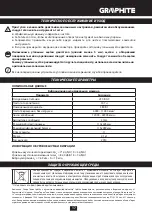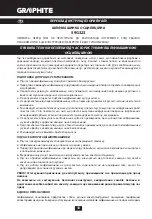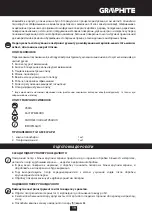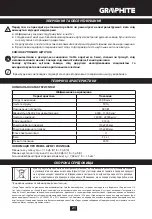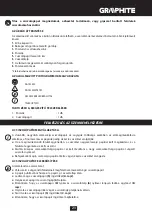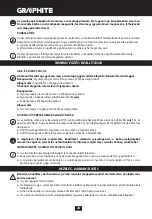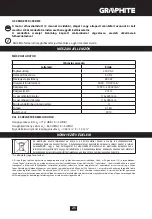
10
TRANSLATION OF THE ORIGINAL INSTRUCTIONS
FINISHING SANDER
59G323
CAUTION: BEFORE USING THE POWER TOOL READ THIS MANUAL CAREFULLY AND KEEP IT FOR FUTURE
REFERENCE.
DETAILED SAFETY REGULATIONS
When sanding wood and metal surfaces coated with paints with lead additives, harmful or toxic dust may
appear. Contact or inhalation of such dust may endanger operator’s or other persons’ health. Use appropriate
personal protection measures such as filter masks and safety glasses. Use dust extraction system.
PRIOR TO SANDER OPERATION
During operation hold the sander firmly with both hands.
●
Ensure the sanding paper does not touch processed material prior to switching the sander on.
●
Ensure the abrasive paper is well installed and paper clamping levers are in locking position before switching
●
the sander on.
Do not touch moving parts of the sander.
●
After switching off, do not put away the sander until all moving parts stop.
●
Use protective mask if the dust appears during sanding. Dust, which appears when sanding surfaces
●
coated with lead-based paint, some types of wood and metal, is harmful.
Pregnant women and children should not enter the room where lead-based paint is removed with the
●
use of sander.
Do not eat, drink or smoke in the room where lead-based paint is removed with the sander.
●
Avoid using long extension cords.
●
WHEN OPERATING THE SANDER
When using the sander, always wear earmuff protectors and protection half-mask.
●
Sander is not designed for wet operation.
●
Ensure the switch is in the OFF position before plugging the sander to a power supply.
●
Keep the power cord away from moving parts of the sander.
●
Use safety goggles or glasses when operating the sander above head.
●
When operating the sander do not apply excessive pressure that might stop the tool.
●
CAUTION! This device is designed to operate indoors.
The design is assumed to be safe, protection measures and additional safety systems are used, ne-
vertheless there is always a small risk of operational injuries.
CONSTRUCTION AND USE
Finishing sander is a hand-held power tool driven by a single-phase commutator motor. Due to a proper
insulation there is no possibility to touch any metal parts that accidentally might be live. The sander does
not require earth lead (insulation class II). Finishing sander is designed for surface sanding of wood products,
polishing wood surfaces with lacquer coating, fine polishing of lacquered metal surfaces, removal of rust
or specks of lacquer before applying new lacquer, finishing of concrete surfaces etc. Range of use covers
repair and building works, woodworking and any work from the scope of individual, amateur activities
(tinkering).
Do not use the sander for sanding surfaces that contain magnesium or asbestos, or covered with
gypsum.
Summary of Contents for 59G323
Page 2: ......
Page 4: ...4 2 1 6 5 5 7 3 A 5 C 5 E 2 1 PRESS D 4 3 B 6 8 F 7 ...
Page 82: ......
Page 83: ......
Page 84: ......

















